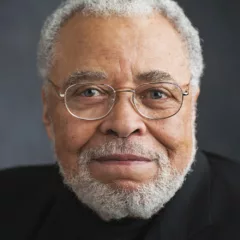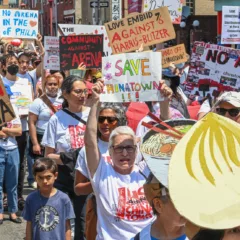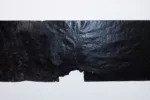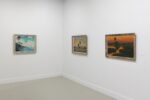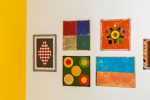Episode 276 – Roberta and I discuss Mayor Parker’s town hall, an installation by Scott Kip at Arcadia University, the death of arts writer Stephan Salisbury and the actor, James Earl Jones, a Seeds powwow at Cherry Street Pier, a print shop in Jenkintown, Fringe and Cannonball festivals, Black Circus Week, Esperanza’s new theater season, a drawing marathon at the Plastic Club.
We find our way to New York City and discuss Jenny Holzer at the Guggenheim and Liz Magic Laser’s New York Times article, “Donald Trump and the meaning of a raised fist.” We hope you enjoy! ~Ryan
Click to expand the podcast transcript
Roberta: Hi everyone, it’s Roberta.
Ryan: And this is Ryan and this is the Midweek News
Roberta: On Artblog Radio. I had four things I wanted to mention just briefly in the news portion. You probably got the email from Vox Populi that said there’s a town hall meeting that (Mayor) Cherelle Parker has called for tomorrow night at 6:00 PM I really think we ought to shout that out.
Ryan: I mean, I got several emails from several different people on that exact topic. And the birthday cake they made too for her.
Roberta: For who?
Ryan: For the mayor. The mayor’s birthday cake. It said, “Happy Birthday Mayor Parker. Save Chinatown.”
Roberta: Is she having a birthday tomorrow?
Ryan: I guess. I mean, I don’t know when her birthday is (Sept. 9 is her birthday), but somebody knows and somebody got it ready.
Roberta: Oh, funny. Okay.
Ryan: But it sounds like this was a last minute meeting call…I don’t know if that’s good or bad.
Roberta: Right. Me neither.
Ryan: Generally make me think it’s bad.
Roberta: Yes. Like there’s something that she’s going to endorse. Or, in the best of all possible worlds, she might stop it, but I don’t know. We’ll see.
Scott Kip up at Arcadia. I want to talk just briefly about that. There’s an opening on September 12th. And it’s like he constructed a little pseudo-proto house inside the gallery that you can wander up some stairs and look around. Kind of a mystery cabinet only bigger. It should be really marvelous. Cabinet of Marvels.
Then Stephan Salisbury died. He was an arts writer for the Inquirer for many years. Really good. He wrote about the business side of the arts, more than reviews. But he knew everything. He knew everybody. Everybody read him. He interviewed Libby and me when Artblog turned 10. It was a wonderful writeup in the Inquirer. He was a very generous, good writer, so that’s really sad that he died. He was 77.
Then there’s a Powwow at Cherry Street Pier on the 21st and 22nd. The Seeds, Philly are celebrating five years. And there’s another celebration, for a print shop that I just heard about called 7 0 5 West Print Shop. It’s in Jenkintown. They’ve been there for 10 years. They have a sustainable, non-toxic materials platform. They have a creative space for people to come and work, and a gallery. And I’m always happy to hear about other things going on. I was not aware of them. So tho those are my four things, Ryan.
Ryan: I can fill a couple sheets, haha, but I try to keep it to three anyway.
Alright, well let me get to my three things. So, obviously I do my theater pick. Right now is Fringe Festival as well as Cannonball Festival. There’s a lot of events going on. Cannonball is running through the 29th of September and their main locations are going to be Icebox, Maas, the Christ Church Neighborhood House. And then there’s also some that are outdoors as well. Take a look at those. Some are going to be in Fairmount Park, some are going to be along the river. There should be some interesting shows. I wanted to point out that the 11th of September is (the last day of) Black Circus Week on Cannonball. So if you haven’t seen that, that’s going to be really interesting to see. They’ve been going for a few days already. I think they started on the sixth. Those shows are ongoing and there’s a lot of different things that are happening there. So take a look at that. Esperanza has announced their latest season, so if you live in that North Philly neighborhood, enjoy that. It looks like a good season.
Speaking of people who have passed away, James Earl Jones passed away. Darth Vader.
Roberta: Huge, huge loss. He was 93. So he had a good long life.
Ryan: He had a long run.
Ryan: The annual Plastic Club Drawing Marathon. I don’t know why I love Quilt-a-thons and draw-a-thons, but I think that could be a lot of fun. That’s coming up on the 15th. 10:00 AM to 10:00 PM
Roberta: Could be fun.
Ryan: 10:00 AM to 10:00 PM
Roberta: Maybe. Do you like that? Maybe the people don’t stay there the whole day. Maybe they come in shifts, you know, shift work.
Ryan: I’m sure. But if you’re in a funk or want a spot or want to switch something up, sometimes you just need a little extra push or whatever, or, need to mix it up a little bit. This could be a fun way of doing that. So that’s coming up this Sunday, the 15th from 10:00 AM to 10:00 PM.
Ryan: I’m trying to redesign my house in a way of the Danish hygge, the comfy setting.
Roberta: Okay.
Ryan: I’ve never been to Denmark, but I spent quite some time in the Netherlands, and they say — I can’t do the guttural G, but they say “gesellig.”
Roberta: Oh my.
Ryan: And so the “gesellig” is also that kind of cozy. Where spending time with people can be cozy or the ambiance can be cozy or sipping some tea by candlelight can be cozy. A lot of different things can fit that. So, I’m rearranging my spaces in my house with that mindset.
Roberta: Pillows. More pillows.
Ryan: Pillows keep coming up. Pillows are a great answer. I need more pillows. And I fixed my record player, so I think that’s cozy. I had to solder some of the old lines, so I think it’s pretty old.
Roberta: Oh my God, soldering…. Speaking of “hygge” when I was in New York, we were uptown walking to the Guggenheim, and we were dying for coffee. I was the afternoon, late afternoon — Ole and Steen. And it was “hygge.” It was Danish, and delicious coffee, and amazing breads. And a coffee cake that was to die for, just a very simple cinnamon coffee cake. Highly recommend it. I couldn’t tell you where it is, but you can look it up. Ole and Steen. I will look it up and we’ll put the link in. It’s nice when you stumble upon places unexpectedly and you have no expectations whatsoever. And it was just wonderful. They had couches to sit on. And leather-covered Danish modern furniture next to the couches and coffee tables.
Ryan: But I was going to say and maybe we’ll have to get your husband’s input on this, but as we’re coming up to the election, I don’t know if you’ve been as inundated by election PR. I get texts and I wonder what am I setting up or going to to get on those lists for political texts? I’ve never signed up at the political sites because that would be crazy. And they just keep saying, Hey. I know you don’t live in my district, but would you come out and support? No. No, I will not. Are you kidding me? Who are you? You’re the chief of staff of some yahoo in some district. I don’t even know. And I didn’t even know if you’re legitimate. And how did you get my number? And I delete it. Right. I’ve just been inundated.
I find so much of the political news to be just shy of fancy and whimsical and it’s bipolar. One day it’s this and next day this, it’s like back and forth, but is not that dramatic of a shift back and forth day to day.
The podcast I try to listen to or the news that I try to incorporate is a little bit more or significantly more consistent in their viewpoints and consistent in their fact checking and their perspectives and a little less meandering this line to see what sells or what people will respond to and react to.
It’s like is always, they’re always creating news now for an algorithm, like what gets people excited.
Roberta: Oh, absolutely. Screaming headlines. I mean, that’s always been the way you sell newspapers, right? Think of the old trope of the newsboy on the corner hawking the newspapers, and you’d hear them shout out the the screaming headlines.
That would always be what sold a newspaper. So not necessarily the content in the article, but the news in the headlines would be inflammatory. And that still holds. There’s too much information. We are bombarded on a. 24/7, 365 basis with too much information. We don’t need all that information.
I mean, I love information. I really like information, but I don’t need to know all of it every day, every minute of every day. You know, it’s like, leave me alone. Please.
Ryan: Very much inundated with just more,
Roberta: Ryan, since we’re meandering, I’m just going to meander right into another news article (haha) that I read today, this was an op-ed piece on the New York Times by Liz Magic Laser, who is an artist, experimental video and performance artist. (Read a piece by Roberta’s sister, Cate Fallon, about a Liz Magic Laser performance in Times Square in 2011.)
Libby and I have been following Liz Magic Laser for quite a while. We first encountered her, I can’t even tell you when and where, but she’s pretty fascinating if you look her up. The article that she had was photo based. And it was about the use of the closed raised fist as a symbol. Who gets to use the raised fist and what it means. And if you think historically the fist raise was a Black Power gesture, Black athletes used it at the Olympics in Munich. Right. The Black Power activists used it back in the sixties and seventies. And, suddenly, you have Donald Trump raising his fist after there was the assassination attempt, and he gets up and there’s blood on his face, and the first thing he does is raise his fist.
And so she shows all these fists raised, and the question is, whose gesture is it? Who owns the gesture? Can you own a gesture? And what does it mean? Has it crossed over to mean White power now? She also has a picture of Josh Hawley on January 6th, 2023, where he was giving a white power, I guess let’s call it that — a raised fist in a gesture of support to the Insurrectionists. I don’t know. And there’s so much symbolism in a raised fist.
In the piece was a historical picture of during the the rise of fascism In England. There was a picture of people rallying in Trafalgar Square. In the background around the statues in the middle of Trafalgar Square, there were all these fascists with their hands raised. They don’t use the closed fist, they use the hands up salute (like the Hitler salute), and surrounding them closer to the front in the photo, were the union guys with their closed fists raised. And so it was this great gestural congregation or standoff of the two opposing gestures.
Nowadays, I guess the right wing militias use the Hitler salute with the open hand. But apparently the closed fist, raised fist. Is it a problem now? Nobody owns it. Everybody’s using it. What does it mean?
Ryan: Things come and go like that. I think there’s a lot of symbolism that gets reinterpreted, reused and reappropriated for its current usage and purposes. Gestures and words. Words do that too. Words have come and gone.
Roberta: Indeed
Ryan: Changed meaning. I have a lot of queer friends. Queer meant a lot of different things in the last a hundred years. Now it’s something that’s owned.
Roberta: That’s right. And gay too. Gay means something different. Speaking of words. Yes.
Ryan, I’m going to meander. Over the weekend I was in New York. (See photos on Flickr.) And we went to Art on Paper Fair, which was marvelous. Bertrand Productions from Philadelphia had a booth, and kitty-corner from that was Commonweal, and both booths were really very lively and I hope they did very well.
They had a lot of fun things that they were both showing. There was another gallery that I saw, Michele Mariaud from Long Island, used to be in New York, showing a French second generation Fauve painter, Josquin, really luscious, beautiful paintings, abstract with the Fauve color palette, the oranges and greens and blacks, and oh my gosh, it was so gorgeous.
And then someone who I think was a self-taught artist,Thierry LeFort, had some very Film Noir paintings that looked like they were right out of Raymond Chandler’s Los Angeles, if he had made a graphic novel. You know, no people in the scene, but tall, towering palm trees and roads that seemingly went nowhere and no cars on them. And they were beautiful, beautiful. Three colors only. The brown paper was in the background, black, and this dense, gorgeous electric blue that looked like it was tempera paint. It had no sheen to it whatsoever. It was just dense, pigmented color. I wanted them, they were so beautiful.
Then we went up to the Guggenheim. I was with my sister Cate, and we went up to the Guggenheim to see the Jenny Holzer. I guess I’m swinging around to words again in this meander. It took me a minute. Jenny Holzer is of course known for her word art. That is mostly what she does. And in 1977 to 79, she wheat pasted her word art all over Soho and New York and she called them truisms. For example, “Abuse of power comes as no surprise.” That’s one of my favorites. But there’s “Professionals are crackpots.” “Bad intentions can yield good results.” “Categorizing fear is calming.”
I mean, to a certain degree it’s a word salad that she throws at you. And at the Guggenheim, it was on the ramp, the inner wall of the ramp that snakes up/down. And it was this marvelous word salad that you couldn’t really stop to read so much, because it was just mesmerizing in the movement and the color. This was a reinstall, or not a reinstall, but a re-creation of what she had installed in the Guggenheim a long time ago with LED lights.
And I’m not sure if this new installation was with LED lights or not. I don’t know what the technology is, but it, it seemed to me and Cate it might have been video, like she videoed it, but I don’t know. You’d be able to figure it out, Ryan. And if you, if you put your hand over the railing where the LED lights were (ahem), you could see that there were little individual light bulb-looking things in the scroll. So it may well be video flowing on strips of LEDs?
Ryan: And were they moving, were the words moving or were they stationary?
Roberta: Oh, they move like a snake,
Ryan: Like a ticker tape?
Roberta: Yes. It was exactly a ticker tape.
Ryan: interesting.
Roberta: From the bottom, starting at the bottom and going up to the top and it was multiple. One scroll would start at the bottom and snake up to the second level, and then the same scroll would start all over again at the bottom, so you had two, and then three, four, five (5 levels). It’s five levels high. So there were five levels scrolling at you. I was initially not wanting to go see this because I said, ‘Oh, just spectacle. I’ve seen it before.’
But it was very moving actually to sit with it and let it sort of take over your visual field. It was beautiful and the idea of information coming at you nonstop was exactly what we talked about earlier, Ryan. We get information thrown at us from all different places, and this was just sort of a visual representation of that as well.
Ryan: That sounds really interesting. When I’m reading I often have a notebook with me to write down little pieces that I find powerful, transportive or useful. It might something I want to reflect on later. And it sounds like that would be something up my alley for the Truisms or whatever my mother calls them.
Roberta: I think the show is up at the Guggenheim until the 29th of September, so there’s time to run up and see it. It’s in its last days. It’s been there since June I think. All summer long. And you can read Holzer’s Truisms online. There are places that have them, you know, aggregated.
Ryan: That’s interesting. I think that could be really powerful and I would love to see more public art in this city. We, we’ve gone to murals, which I think are great. I think things like this could be really great as well for public art.
Roberta: It’s great public art. But inside the Guggenheim, it’s not really public.
Ryan: This one specifically, not so great. I think public is required (in public art).
Roberta: But you know what. I don’t know when, but back in the day she had LED ticker tape scrolls in Times Square, so her art is public. Has always been. She projects on the exterior of buildings.
Ryan: Right.
Roberta: And we’ve done that here. Nadia Hironaka and Matt Suib have projected images on buildings, exteriors at night.
Ryan: Great. I’d love if we had more of that.
That’s a lot of meandering! That’s pretty good meandering.
Roberta: We gobbled up a lot of airtime, meandering, so maybe we ought to, you know, saw it off here and say, let’s talk again. Reconvene next week. Let’s say arrivederci. And this is Roberta saying, Bye-Bye.
Ryan: And this is Ryan, and this has been the Midweek News on Artblog radio. Bye-Bye.
Meet Our Hosts





